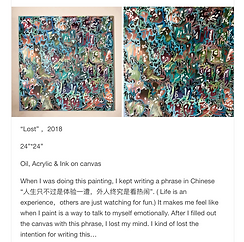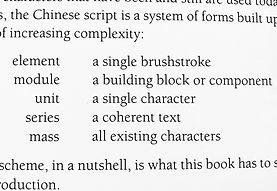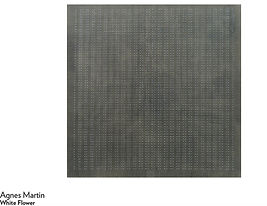Training, testing and rebalancing trough Artwork creation
My studio practice is aroused by my actual experiences of making my previous paintings called “Mental Series”. At that time, I had been through a very depressive period. I continually wrote one comfort sentence on canvas as a way to talk to myself. And it was unexpected I forgot the reason why I was depressed after I finished my painting.

Figure 1: Mental Series 2018.
Base on further research, my recent painting practice combine abstract Chinese character and self-rebalancing idea from therapeutic art, together to create artwork through a highly concentrate mark making process, in which I try to lead myself forgot the intention of making painting then catch a new level of consciousness - ecstasy.
I used to paint through writing Chinese character as kind of self-expression to depict my day life experiences. Because I think writing and painting are different approaches to the same end - expressing. In my recent paintings, I want to keep the activity of writing and do not want to show the actual word/character. Abstracting Chinese character into a minimal way “|||” three parallel short lines which I got the idea from Lothar Ledderose. (2000, p.10) He said: “the Chinese script is a system of forms built up in a hierarchy of five levels of increasing complexity: mass - series - unit - module - element.”


Figure 2 & 3: Chinese script system (Ten thousand things, 2000)
Also, in traditional Chinese painting they think three is a balanced structure in composition. (Keding, 2015) Using “|||” as a personal motif of mark making process and creating repetition layer by layer in relation to the white space on canvas is how I build up my painting. The more important is that I paint these marks with Chinese brush because I want to capture the feeling of writing to myself. Inventing artist’s own vocabulary and grammar as the basis of a personal and frequently cryptic language, had become private system of rules for twentieth-century’s artists. (Rosenblum, 1999, p.4) I think this idea still work for unpredictable, aesthetic reasons in recent century.
Suffering severe insomnia has been a common daily situation for me. Because I cannot control myself to re-thinking/re-living the event/thing which existed before. It is very anxious and restless. As for the reasons why they re-existing in my mind are different, and I still did not summarize the rule. Referencing Sigmund Fred’s idea from <<Beyond the Pleasure Principle>>, he identifies this activity as “Repetition Compulsion”. He thinks repetition compulsion appears unconsciously base on suffering repressed, traumatic material in life as a kind of self-repairing mental activity. He believes the repetition compulsion has the significance towards the preservation of life, which works as the same as sexual instincts. “Sexual instincts reproduce primitive states of the living being, but they aim they strive for is the copulation of two individual protozoa, the repetition.” (Fred, 1847, p.35) Repetition appears because the mental needs and it help us to a better living. Meanwhile, I get support from the book <<Art as Therapy>> which depicts some functions of art, especially - Rebalancing and Sorrow. (Botton, 2016, p.24-38) “Art can put us in touch with concentrated doses of our missing dispositions, and thereby restore a measure of equilibrium to our listing inner selves.” “Many said things become worse because we feel we are alone in suffering them. We need help in finding honour in some of our worst experience, and art is there to lend them social experience.” According to these theories, I realize the consequence of my art practice. I am doing an art therapy for myself and trying to introduce this creating activity to more people who might trap in a bad mood and need self-salvation.
It is very fortunate my inner self repetition and repetitive mark making match together in my art practice. For my artistic expression, my paintings are influenced by Sol LeWitt’s concept about artist’s satisfied outcome, Kazimir Malevich’s infinite white space, and Agnes Martin’s creative attitude about life and minimalist vocabulary. Sol LeWitt talked about his wall drawing: “as long as the plans were followed, the artist is satisfied with the wall drawing. What they look like is not important to artist.” (Gross, 2012, p. 12)


Figure 4: Wall drawing #797 (MASS MoCA, 2020)
Figure 5: Line form Points to Points, 1975. (Sol LeWitt, 2012)
I referenced this concept of creating art in my artwork, through writing words/sentences without concrete shape. It is not important for audience to see what I have wrote. The high concentrate mark making process is important and it guides me into a certain level of consciousness – ecstasy which I think it is also a representation of satisfying. Base on Malevich’s idea of Suprematism and my personal aesthetic reason, I work on a pure white canvas and arrange the white space.


Figure 6 & 7: Suprematist painting (Kazimir Malevich, 2003).
The white space I left on purpose in my painting depicts geometric shapes and object matters. It not only creates a second demotion of painting but also an imaginative space for the audience. Agnes Martin said: “Life moves according to a growing consciousness of life and is completely unpredictable… You must believe in life. Believe that you can know the truth about life.” (Glimcher, 2012, p.164) The idea of suffering and her positive attitude moves me. By seeing her artworks which gives me a huge support on keep: “defining simple geomatic vocabulary, working with reduce means and employing a process of repetition”.


Figure 8 & 9: Little Sister & White Flower (Guggenheim, 2020)
Based on my current exploration, I will continue working on repetition mark making which I need to arrange the motif and outcome to be more systematic to match my own esthetics. I am attracted by minimalist art and concept art. Try to work with other material is necessary. Moreover, I named my painting process: training, testing and rebalancing, because the time, mood, and result are unknown until I finished. I might make my artwork as performance art or record the process of making painting which will be much more helpful to express my idea. I am creating therapeutic art and introduce this activity to other people, and I want to be more rigorous and sum up some consensus outcome done by this activity.
Bibliography:
Botton, A.D., 2016. Art as therapy, S.l.: Phaidon.
Drutt, M., & Malevič Kazimir. (2003). Kazimir Malevich: suprematism. New York: Guggenheim Museum.
Freud, S. (1948). Beyond the pleasure principle; authorized translation from the second German edition. London: Hogarth Press and Institute of Psycho-analysis.
Fer, B., Ackermann, M., Lovatt, A., Morris, F., Bell, T., Barker, R., … Trockel, R. (2015). Agnes Martin. London: Tate Publishing.
Glimcher, A. B., & Martin, A. (2012). Agnes Martin: paintings, writings, remembrances. London: Phaidon.
Gross Béatrice, & Wittocx, E. (2012). Sol LeWitt. Metz: Centre Pompidou-Metz.
Keding, H. (2015). Zhongguohua Jifa Yanjiu, China Book Press.
Ledderose, L., 2000. Ten thousand things: module and mass production in Chinese art, Princeton (N.J.): Princeton University Press.
LeWitt, S., & Legg, A. (1978). Sol LeWitt. New York: The Museum of Modern Art.
Martin, A., Anastas, R., Cooke, L., Kelly, K. J., & Schröder Barbara. (2011). Agnes Martin. New York: Dia Art Foundation.
Rosenblum, R. (1999). On modern American art: selected essays. New York: Harry N. Abrams.
Retrieved January 19, 2020, from https://www.guggenheim.org/artwork/artist/agnes-martin
Sol LeWitt: A Wall Drawing Retrospective - MASS MoCA - Google Arts & Culture. Retrieved January 19, 2020, from https://artsandculture.google.com/exhibit/sol-lewitt-a-wall-drawing-retrospective/4QKScTdreqHKIA

